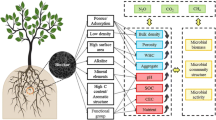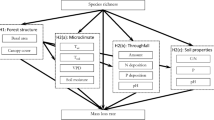Abstract
Microclimate was recorded and soil organisms were collected 1997-1999 in ecosystem stands of contrasting structure in central Amazonia (a primary forest, a 12-year secondary forest, two different agroforestry systems, a rubber tree (Hevea brasiliensis) plantation, and a peach palm (Bactris gasipaes) monoculture with a densely closed canopy). The aim was to look at the effects of canopy closure on microclimate and soil organisms. Monthly maxima temperature, average air and soil temperatures, and saturation deficit were highest in September 1997, and total annual rainfall in 1997 was 12-28% lower than in the other study years. The monthly average litter temperatures were consistently 2-4 °C higher in the plantation sites than in the rainforest and the secondary forest, and temperatures on single days (not the monthly averages) in the plantations were up to 10 °C higher than in the primary forest. The highest average litter and soil temperatures and the highest temperature maxima were recorded in the agroforestry plantations. Canopy closure strongly determined the litter temperatures in the sites. Soil macrofauna biomass was also strongly correlated to canopy closure (linear regression, P = 0.05). We conclude that a well developed canopy effectively protects the soil macrofauna from high temperature variation and drought stress. Therefore, optimizing these agroforestry systems for canopy closure may contribute to a better management of the beneficial soil decomposer community.
Similar content being viewed by others
References
Amelung W., Martius C., Bandeira A.G., Garcia M.V.B. and Zech W. 2001. Lignin characteristics and density fractions of termite nests in an Amazonian rain forest-indicators of termite feeding guilds? Soil Biology and Biochemistry 34: 367–372.
Begon M., Harper J.L. and Townsend C.R. 1996. Ecology: individuals, populations and communities. 3rd (ed.), Blackwell Science Ltd, London, UK, 1068 pp.
Bierregaard R.O. Jr., Gascon C., Lovejoy T.E. and Mesquita R. 2001. Lessons from Amazonia: the ecology and conservation of a fragmented Forest. Yale University Press, New Haven, Connecticut, USA.
Bohlman S.A., Matelson T.J. and Nadkarni N.M. 1995. Moisture and temperature patterns of canopy humus and forest floor soil of a montane cloud forest, Costa Rica. Biotropica 27(1): 13–19.
Borchert R. 1994. Water status and development of tropical trees during seasonal drought. Trees 8: 115–125.
Bunnell F.L. and Vales D.J. 1990. Comparison of methods for estimating forest overstory cover: differences among techniques. Can. J. For. Res. 20: 101–107.
Collado R. and Schmelz R. 2000. Pedonais crassifaucis n.gen., n.sp. (Naididae) and Bothrioneurum righii n.sp. (Tubificidae), two new tropical soildwelling species of “aquatic” oligochaetes (Clitellata, Annelida) from Central Amazonia. Amazoniana 16: 223–235.
Cook J.G., Stutzman T.W., Bowers C.W., Brenner K.A. and Irwin L.L. 1995. Spherical densiometers produce biased estimates of forest canopy cover. Wildlife Society Bulletin 23: 711–717.
Ewel J.J. 1999. Natural systems as models for the design of sustainable systems of land use. Agroforestry Systems 45: 1–21.
FAO/ Unesco 1990. Soil map of the world, revised legend. World Soil Resources Report 60. FAO, Rome, Italie, 119 pp.
Feldmann F., Idczak E., Martins G., Nunes J., Gasparotto L., Preisinger H., Moraes V.H.F. and Lieberei R. 1995. Recultivation of degraded, fallow lying areas in central Amazonia with equilibrated polycultures: response of useful plants to inoculation with VA-mycorrhizal fungi. J. Appl. Bot. 69: 111–118.
Franklin E.N., Morais J.W. and Santos E.M.R. 2001. Density and biomass of Acari and Collembola in primary forest, secondary regrowth and polycultures in central Amazonia. Andrias 15: 141–153.
Ganey J.L. and Block W.M. 1994. A comparison of two techniques for measuring canopy closure. Western Journal of Applied Forestry 9: 21–23.
HÖfer H., Hanagarth W., Beck L., Garcia M., Martius C., Franklin E. and RÖmbke J. 2001. Structure and function of the soil fauna in Amazonian anthropogenic and natural ecosystems. Eur. J. Soil Biol. 37: 229–235.
Jolliffe P.A. 1997. Are mixed populations of plant species more productive than pure stands? Oikos 80(3): 595–602.
Kurzatkowski D., Martius C., HÖfer H., FÖrster B., Beck L. and Vlek P. 2004. Litter decomposition, microbial biomass and activity of soil organisms in three agroforestry sites in central Amazonia. Nutrient Cycling in Agroecosystems. In press.
Lal R. 1995. Sustainable management of soil resources in the humid tropics. United Nations University Press, Tokyo, Japan, 146 pp.
Lavelle P., Bignell D., Lepage M., Wolters V., Roger P., Ineson P., Heal O.W. and Dhillion S. 1997. Soil function in a changing world: the role of invertebrate ecosystem engineers. Eur J Soil Biol 33(4): 159–193.
Lechner M.D. 1992. D'AnsLax Taschenbuch für Chemiker und Physiker, Band I Physikalischchemische Daten. 4th. edition. SpringerVerlag, Berlin, Germany, 768 pp.
Martius C., Garcia M.V.B., HÖfer H., RÖmbke J. and Hanagarth W. 2004. Litter fall, litter stocks and decomposition rates in rain forest and agroforestry systems in central Amazonia. Nutrient Cycling in Agroecosystems. In press.
Naeem S., Håkansson K., Lawton J.H., Crawley M.J. and Thompson L.J. 1996. Biodiversity and plant productivity in a model assemblage of plant species. Oikos 76: 259–264.
Nijs I. and Roy J. 2000. How important are species richness, species evenness and interspecific differences to productivity? A mathematical model. Oikos 88: 57–66.
Preisinger H., Coelho L.F., Siqueira M. do S.G. and Lieberei R. 1994. Analysis of growth form types and floristic composition of the spontaneous vegetation in an agricultural test area near Manaus, Amazonas, Brazil. Angew Botanik 68: 40–46.
Ribeiro J.E.L., Hopkins M.J.G., Vicentini A., Sothers C.A., Costa M.A.S., Brito J.M., Souza M.A.D., Martins L.H.P., Lohmannn L.G., Assunção P.A.C.L., Pereira E.C., Silva C.F., Mesquita M.R. and Procópio L.C. 1999. Flora da Reserva Ducke. Guia de indentificaç ão das plantas vasculares de uma floresta de terra firme na Amazonia Central. INPA-DFID, Manaus, 799 pp.
Ribeiro M.N.G. and Adis J. 1984. Local rainfall variability a potential bias for bioecological studies in the Central Amazon. Acta Amazonica 14(12): 159–174.
Römbke J., Meller M. and Garcia M.V.B. 1999. Earthworm densities in central Amazonian primary and secondary forests and a polyculture forestry plantation. Pedobiologia 43: 518–522.
Whitmore T.C. 1998. An introduction to tropical rain forest. 2nd ed. Oxford University Press Inc., New York, New York, USA, 251 pp.
Wolter K. and Timlin M.S. 1998. Measuring the strength of ENSO-how does 1997/98 rank? Weather 53: 315–324.
Young A. 1997. Agroforestry for soil management. CAB International, Wallingford, UK, 320 pp.
Author information
Authors and Affiliations
Corresponding author
Rights and permissions
About this article
Cite this article
Martius, C., Höfer, H., Garcia, M.V. et al. Microclimate in agroforestry systems in central Amazonia: does canopy closure matter to soil organisms?. Agroforestry Systems 60, 291–304 (2004). https://doi.org/10.1023/B:AGFO.0000024419.20709.6c
Issue Date:
DOI: https://doi.org/10.1023/B:AGFO.0000024419.20709.6c




